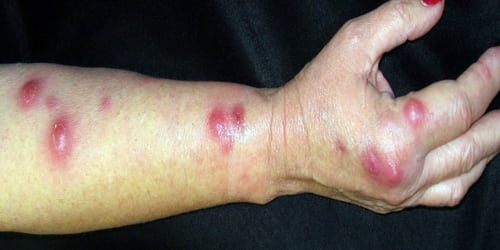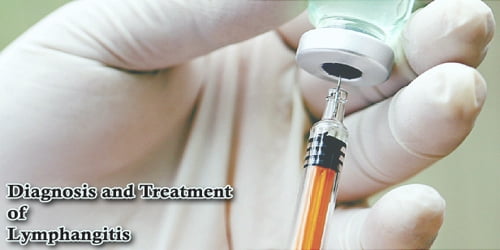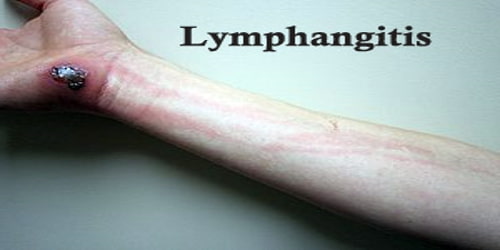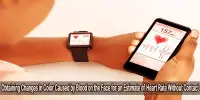Lymphangitis
Definition: Lymphangitis is an inflammation of the lymphatic system, which is a major component of our immune system. The most common cause of lymphangitis in humans is Streptococcus pyogenes (Group A strep), although it can also be caused by the fungus Sporothrix schenckii. The bacteria enter the body through a cut, scrape, bite or wound of some sort. The bacteria can get into the lymphatic system, which is part of our immune system. The bacterial infection spreads rapidly in the lymph channels (causing the red streaking) and lymph nodes (causing hard swollen “knots” under the skin).
Lymphangitis is sometimes mistakenly called “blood poisoning”. In reality, “blood poisoning” is synonymous with sepsis.
Our lymphatic system is a network of organs, cells, ducts, and glands. The glands are also called nodes and can be found throughout our body. They are most apparent under our jaw, in our armpits, and in our groin.
Organs that make up the lymphatic system include our:
- tonsils, which are located in our throat
- spleen, an organ in our abdomen that purifies our blood, among other functions
- thymus, an organ in our upper chest that helps white blood cells develop
Infectious lymphangitis occurs when viruses and bacteria invade the vessels of your lymphatic system, typically through an infected cut or wound. Tender red streaks often radiate from the wound toward the nearest lymph glands. Other symptoms include fever, chills, and a general sense of illness.
Causes, Sign, and Symptoms of Lymphangitis: Lymphangitis is the inflammation of the lymphatic vessels and channels. This is characterized by certain inflammatory conditions of the skin caused by bacterial infections. Thin red lines may be observed running along the course of the lymphatic vessels in the affected area, accompanied by painful enlargement of the nearby lymph nodes.
The most common infectious cause of lymphangitis is the acute streptococcal infection. It may also be the result of a staphylococcal (staph) infection. Both of these are bacterial infections. Conditions that increase your risk of lymphangitis include:
- diabetes
- immunodeficiency, or loss of immune function
- chronic steroid use
- chickenpox
A cat or dog bite or a wound made in freshwater can also become infected and lead to lymphangitis. Gardeners and farmers may develop the condition if they get sporotrichosis, a soil-borne fungal infection.

There are also noninfectious causes of lymphangitis. Inflammation of lymph vessels can occur due to malignancy: Breast, lung, stomach, pancreas, rectal, and prostate cancers are common types of tumors that can lead to lymphangitis. Lymphangitis has also been seen in those with Crohn’s disease.
Signs and symptoms include a deep reddening of the skin, warmth, lymphadenitis (inflammation of a lymphatic gland), and a raised border around the affected area. The person may also have chills and a high fever along with moderate pain and swelling. A person with lymphangitis should be hospitalized and closely monitored by medical professionals.
There are some more symptoms of this disease which are as follows:-
- Swollen lymph glands
- Liner red streaks from the place of infection towards the lymph node
- Fever
- Reddening of the skin (chest, face, hand, leg, back etc)
- Warming of the skin
- A headache
- Rashes on the skin
- Puking tendency
- Loss of appetite
- Malaise
- Chills
Diagnosis and Treatment of Lymphangitis: This particular disease cannot be detected unless a physical test is done. However, the doctors can say from the inflammations of the lymph nodes, open wounds, and red streaks. For further confirmation, they suggest a biopsy or blood culture test to check if the infection has spread to the bloodstream.

Treatment should begin immediately to keep the condition from spreading. The doctor may recommend the following:
- antibiotics, if the cause is bacterial — in the form of oral medication or intravenous antimicrobial therapy, which involves antibiotics given directly into our veins
- pain medication
- anti-inflammatory medication
- surgery to drain any abscesses that may have formed
- surgical debridement, or removal, of a node if it’s causing obstruction
The infected area should be kept at an elevated position to reduce swelling and slow down the infection from spreading. At home, take hot compresses to ease down the pain. Repeat this technique multiple times every day for at least twenty to thirty minutes. The patient can also wet a soft piece of cloth in warm water and keep it in the areas of inflammation. Hot showers can also be taken. It will aid in healing and increase the blood flow. But make sure that the cloth has not soaked water that is too hot as that may lead to further complications.
If possible, keep the infected area elevated. This helps reduce swelling and slows the spread of infection.
Information Source:
















